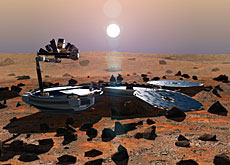Space-X takes pictures on Mars

Micro-cameras developed by a small Neuchâtel company have flown to Mars as part of the European Space Agency's first mission to the red planet.
The cameras, put together by the Space-X company after more than ten years of research, will be seeking traces of life and water on the planet.
After travelling for about six months, the Beagle 2 lander, which houses the cameras, will leave the Mars Express orbiter for the final five-day descent.
If all goes according to plan, the cameras will deliver pictures of Mars in a matter of hours after landing.
Three cameras
Space-X, a spin-off from the Swiss Centre for Electronics and Microtechnology, is providing three cameras for the mission, which took off on Monday.
“Two will equip a stereo system and the other is part of the microscope,” Space-X project manger Stéphane Beauvivre told swissinfo.
The two stereo cameras will provide digital pictures from which a 3D model of the area within reach of the robotic arm can be constructed.
Since the arm of the lander cannot be operated in real time because of the distances involved, the 3D model will be used to guide the instruments into position alongside target rocks and soil and to provide information on the geological setting of the landing site.
The job of the microscope is to pick out features of a few thousandths of a millimetre on rock surfaces. This will reveal the texture of the rock, which will help determine whether it is of sedimentary or volcanic origin.
High demands
The demands on the cameras are high because they will have to undergo rigorous conditions.
“They will have to experience vibrations and shocks, thermal cycles and operation at very low temperature,” Beauvivre said.
“We’ve done a lot of testing in Neuchâtel to simulate conditions on Mars so that we can be sure they will do the job.
“It will differ from conditions on Earth because, for example, the pressure will be relatively low at around six millibars and the temperature could be down to minus 120 degrees Celsius so this is a harsh environment,” he added.
Beauvivre said ESA chose Space-X cameras for the mission because of its years of experience.
“We were also chosen because we are located in an area where we can find a lot of companies active in microtechnology, based on developments of the watch industry,” he told swissinfo.
Pre-launch nerves
The Space-X team is understandably a little nervous about the mission but it can look back on several successes.
It has delivered a high resolution camera for ESA’s Proba telescope, which is in orbit around the Earth, and a micro-camera for the Advanced Moon micro-Imager Experiment (AMIE), an instrument on board SMART-1, the first ESA mission to the Moon.
“The first success for us will be to have images of the surface of Mars but the real success of course would be if we find traces of life,” Beauvivre said.
swissinfo, Robert Brookes
The digital space micro camera features:
1024 by 1024 pixels CCD
10 bit/pixel resolution
a power consumption of 1.5 W
an operating range of – 120 degrees C to + 30 degrees C
a mass of 110 grams
Space-X of Neuchâtel is providing three micro cameras for the Mars Express mission.
It took more than ten years of research to develop them.
Pictures from Mars can be expected just hours after the Beagle-2 has landed.
Space-X (Micro-Cameras and Space Exploration) is a spin-off from the Swiss Centre for Electronics and Microtechnology in Neuchâtel.

In compliance with the JTI standards
More: SWI swissinfo.ch certified by the Journalism Trust Initiative











You can find an overview of ongoing debates with our journalists here . Please join us!
If you want to start a conversation about a topic raised in this article or want to report factual errors, email us at english@swissinfo.ch.